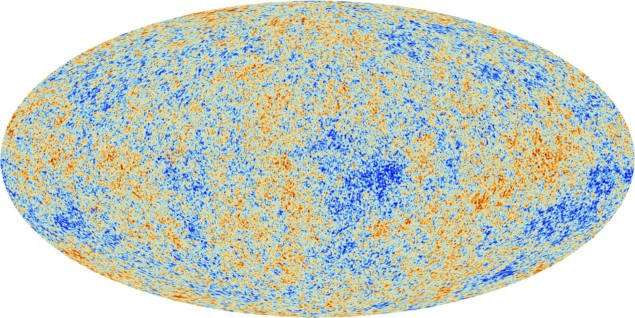
Unexpected hot spots in the cosmic microwave background (CMB) could have been produced by black holes evaporating before the Big Bang. So says a trio of scientists led by mathematical physicist Roger Penrose in a paper presenting new evidence that our universe is just one stage in a potentially infinite cycle of cosmic extinction and rebirth. Other researchers, however, remain sceptical that the microwave background really does contain signs from a previous “aeon”.
According to standard cosmology, the universe underwent a very brief but exceptionally intense expansion just after the Big Bang. This period of “inflation” would have ironed out any irregularities in the structure of the early universe, leading to the very uniform cosmos that we observe around us.
However, Penrose, based at the University of Oxford , has developed a rival theory known as “conformal cyclic cosmology“ (CCC) which posits that the universe became uniform before, rather than after, the Big Bang. The idea is that the universe cycles from one aeon to the next, each time starting out infinitely small and ultra-smooth before expanding and generating clumps of matter. That matter eventually gets sucked up by supermassive black holes, which over the very long term disappear by continuously emitting Hawking radiation. This process restores uniformity and sets the stage for the next Big Bang.
Losing mass
CCC has met with scepticism from many cosmologists since being put forward in 2005, not least because the matching up of an infinitely big universe in one aeon with an infinitely small one in the next requires that all particles lose their mass when the universe gets very old. However, in 2010 Penrose and Vahe Gurzadyan of the Yerevan Physics Institute in Armenia claimed that they had found evidence to support CCC in the form of rings of uniform temperature within the CMB. Those rings, the idea went, would be the signature in our aeon of spherically-emitted gravitational waves generated by colliding black holes in the previous aeon.
The pair found such rings in data from NASA’s Wilkinson Microwave Anisotropy Probe (WMAP), while at the same time claiming that they saw no such pattern in (standard) simulations of the CMB that they had carried out. Other groups, however, argued that simulations did indeed contain rings – once they had been modified to take account of the distribution of hot and cold spots at various angular scales that are seen in the real CMB and which are predicted by inflationary physics.
Undeterred, Penrose has now published a different kind of evidence in support of CCC. Rather than rings of near uniform temperature, he has instead identified patches within the CMB that are much hotter than the surrounding region. The idea is that these hot spots could be due to the (mainly electromagnetic) radiation given off during the Hawking evaporation of supermassive black holes in the previous aeon.
Hawking points
Penrose says that although originally very feeble, those emissions would have been concentrated in our own aeon into spots with huge amounts of energy that he and his colleagues call Hawking points. That concentration comes about, he explains, because “the universe loses track of how big it is at the transition between aeons”. The Hawking points would then have stretched during the early universe, forming circular patches with a diameter on the sky about five times that of the Moon.
In a preprint recently uploaded to the arXiv server, Penrose and two colleagues – Daniel An of the SUNY Maritime College in the US and Krzysztof Meissner at the University of Warsaw in Poland – report scouring CMB data from the European Space Agency’s Planck satellite for hot spots of various sizes and analysing how quickly the microwave temperature drops off around them compared to spots in 1000 simulated maps of the CMB. They found that in and around small spots, not a single simulated map had higher temperature gradients than the real cosmos – with the temperature variations in the latter case being about an order of magnitude higher (some 3×10-4 K) than the CMB average.
Strong backing
According to Penrose, this disparity between real and simulated data provides strong backing for CCC over inflation. “We certainly welcome attempts to explain these observations in terms of currently accepted models,” he says, “but we think this will be hard unless radically new ideas come forth”.

The universe could be caught in a loop and a natural nuclear reactor
Some other physicists, however, remain unconvinced. James Zibin of the University of British Columbia in Canada points out that scientists have been scrutinising the CMB for years and have found no evidence for particularly hot spots (although they have identified one anomalous cold patch). He also reckons that Penrose and colleagues have failed to account for the “look elsewhere” effect, arguing that because they found the hottest spots in the real as opposed to simulated data in just 2 out of 40 tests (focusing on different sizes of spot and CMB border region each time) the chances of having been the victim of a statistical fluke drop from 1 in 1000 to as low as 1 in 50.
Douglas Scott, a colleague of Zibin at British Columbia, is also sceptical. Describing the paper as “very muddled and hard to follow”, he is wary of what he sees as a potentially never-ending series of attempts to find unusual features in the CMB. “Obviously, if someone could show that some specific pattern on the microwave sky was a proof that the universe underwent a series of cycles then that would be spectacularly exciting,” he says. “But this paper falls very short of doing that.”



